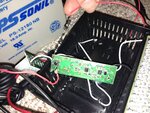davidjamesi
Newbie level 4

Hey there, new to the forum! Have enjoyed lurking and learning stuff, however i have a question for everyone 
I have 6 160 LED video lights for videography. However each takes 6 AA batteries. The lights a supper bright...but not for long!
I would like to eliminate the use of SO many AA batteries by figuring a way to power it off a 12v battery that would last MUCH longer and could power all 6 at once.
From my understanding you would need to run a resistor for every led? of course from the photo you can see the 160 leds are run in parallel...
The photos show the unit stripped down, it includes 2 circuit boards. 1 has the 6 leds and a button on the 2nd circuit board that show the amount of power left in the AA batteries. The other circuit board has a few capacitors (16v 220F) and (16v 470F) and another one that reads "C 600" along with a variable control switch (it broke thats why i ripped this one apart to see if powering off a battery was possible, but keep in mind the other 5 units are in tact and have the variable power piece in tact).
Like stated above, my plan would be to have a plug come out of the back of the unit that can be plugged into a battery. If i could keep the variable power that would awesome, i dont necessarily need the battery capacity checker (6 leds that show amount of power left) but i imagine sense its all tied together it would be find to keep together.
I know i am probable leaving a lot of info out but really would love some insight on how this might be possible!
thanks in advance.









I have 6 160 LED video lights for videography. However each takes 6 AA batteries. The lights a supper bright...but not for long!
I would like to eliminate the use of SO many AA batteries by figuring a way to power it off a 12v battery that would last MUCH longer and could power all 6 at once.
From my understanding you would need to run a resistor for every led? of course from the photo you can see the 160 leds are run in parallel...
The photos show the unit stripped down, it includes 2 circuit boards. 1 has the 6 leds and a button on the 2nd circuit board that show the amount of power left in the AA batteries. The other circuit board has a few capacitors (16v 220F) and (16v 470F) and another one that reads "C 600" along with a variable control switch (it broke thats why i ripped this one apart to see if powering off a battery was possible, but keep in mind the other 5 units are in tact and have the variable power piece in tact).
Like stated above, my plan would be to have a plug come out of the back of the unit that can be plugged into a battery. If i could keep the variable power that would awesome, i dont necessarily need the battery capacity checker (6 leds that show amount of power left) but i imagine sense its all tied together it would be find to keep together.
I know i am probable leaving a lot of info out but really would love some insight on how this might be possible!
thanks in advance.











